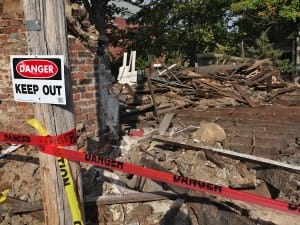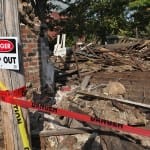Historic house teardown technicalities could add fuel to upcoming UDO debate




The demolition late last week of the house at 523 W. 7th Street was initially analyzed as a flagrant flouting of Bloomington’s due process for assigning historic designation to a property. That’s because the city’s historic preservation commission passed a resolution on Aug 8, recommending to the city council that it vote to designate the house as a separate historic district.
Conor Herterich, the city’s historic preservation program manager, told The Beacon on Monday that the demolition violated the property’s interim protection against demolition—a protection provided by the commission’s resolution.
As of late Tuesday afternoon, however, it appears that the commission’s resolution, initially believed by city officials to have given the house interim protection, was not worded so that the intended protection was given. The meeting minutes from the Aug. 8 meeting say: “…the HPC recommends its historic designation under Title 8 of the BMC to the Common Council with the attached map.” There doesn’t appear to have been any explicit mention of “interim protection.”
Based on information from a source with the city, there’s been an preliminary conclusion by city staff that the property owners did not flout any interim protection, because the wording of the resolution didn’t explicitly mention “interim protection.” According to the source, there’s a second technicality that’s apparently in favor of the property owner, David Holdman. The second technical glitch is the city’s possible failure to give Holdman proper notice of the HPC’s finding and recommendation.
The property owner at 523 W. 7th still violated a provision of city code with his demolition of the house—because he did not have the a proper certificate of zoning compliance, according to the city source. That violation carries a potential fine of up to $2,500, the source said. That’s consistent with the general maximum fine under city code.
Reached by phone on Monday, Holdman told The Beacon that his legal counsel had advised him not to answer questions.
Also appearing to be consistent with information from the source is a statement to The Beacon from the city’s communication director, Yaël Ksander, at around 4:45 p.m. on Tuesday: “It is not clear where things landed along the process of declaring the house’s interim protection status and, accordingly, what violation notices would be issued and conditions/remediations required. The discussion is ongoing.”
If the demolition of the house was at least in part legal, based on technicalities, it could be cited as an example—to support a variety of arguments—in upcoming deliberations by the city council on updates to the unified development ordinance (UDO). The council gets a first reading of the UDO update on Wednesday, with the first hearing likely to be scheduled on Oct. 16. More details of the schedule are expected to be announced Wednesday.
The Beacon spoke with some members of the city council about the demolition before the issue about the technicalities became apparent.
Even without the technical issues—on the question of the 7th Street property’s interim protected status—the earlier-than-expected demolition of the house would have factored into upcoming UDO deliberations.
About the idea that a house that’s undergoing the due process of review by the historic preservation commission could be demolished without any consequence, councilmember Susan Sandberg said: “This is a precedent I don’t want to see set.” Sandberg is the city council’s representative on the city plan commission, which forwarded the UDO update to the city council with a 9–0 recommendation for adoption.
The question of teardowns came up during plan commission deliberations and public commentary on the question: Should the UDO allow duplexes, triplexes and fourplexes in core neighborhoods as by-right use, conditional use, or neither? People expressed a concern that houses would be bought by speculators seeking to turn a profit, who would then tear them down and construct plexes there.
One response heard about that concern at plan commission hearings was the idea that demolition delays, which are a part of the existing and updated UDO, would prevent the demolition of houses that have historic merit. Sandberg said the 7th Street demolition made her wonder if more “teeth” needed to be put into the demolition delays.
Councilmember Steve Volan told The Beacon he thinks stronger enforcement of demolition delays is crucial to allowing plexes everywhere.
Sandberg said she supported an amendment that was considered, but rejected, by the plan commission, which would have strengthened the wording of the updated UDO draft, concerning demolition delays. The amendment would have added a clause that highlights whether a proposed alteration would cause a property to lose its status as a “contributing structure” in an area with historic designation.
Councilmember Chris Sturbaum, who argued in front of the plan commission against duplexes, triplexes and fourplexes in core neighborhoods, and for the amendment on demolition delays, told The Beacon he’d bring forward amendments on those topics when the city council takes up the UDO.
At the Aug. 8 meeting of the historic preservation commission—Sturbaum is the city council’s representative to the HPC—he argued against the idea, reflected in the updated UDO, that “contributing structure” should not trigger a demolition delay. (A “contributing structure” is not as historically significant as one rated “notable” or “outstanding.”)
The 523 W. 7th house is rated a “contributing structure” in the 2015 State Historic Architectural and Archaeological Research Database (SHAARD). But according to the staff city staff report on the house, it was given a “notable” rating in 2003 in an interim report by the City of Bloomington. It was also rated “notable” in a survey conducted by Bloomington Restorations Inc. (BRI) in 2018.
It’s the BRI survey is supposed to be used to evaluate demolition delays in the updated UDO, according to Sturbaum.
The HPC’s decision about the 523 W. 7th Street house was a case of weighing the historic value of a house that’s a part of a community’s story against the individual owner’s own story of tragedy that took place in the house, Sturbaum said.
When Holdman appeared in front the historic preservation commission, he said his brother-in-law was killed in the house, and his mother-in-law has not stepped in it since. (Four years later, the Herald-Times reported that the investigation had still not determined if the brother-in-law’s injury was the result of an accident or foul play.)
Sturbaum sees “contributing structures” as key to maintaining the fabric and context of a historic neighborhood. He does not want to seem them “picked off” one by one, he told The Beacon. Without a coherent context, the value of historic property gets eroded, Sturbaum said.
It’s also the coherence of a neighborhood’s context that city council president Dave Rollo sees as relevant to the demolition of 523 W. 7th Street. He described to The Beacon how in the 1980s and 1990s many of the core neighborhood houses were occupied by student renters—transient tenants with absentee landlords and properties falling into states of disrepair. “It was a bad situation for neighborhoods,” Rollo said.
A few different factors helped to reclaim core neighborhoods for owner-occupied houses, Rollo said. Among them was a restriction on the number of unrelated adults who could live in a place, and the creation of the residential neighborhood parking permit system. Also playing a role was allowing the construction of high-density student housing near downtown, Rollo said. All of that served to draw student renters out of core neighborhoods, he said, and that’s been a good thing for those areas.
The demolition of the 7th Street house does not appear to have resulted from a speculative development interest. But, Rollo said, it’s a reminder of what acute pressure properties near campus and downtown are under. Razing houses to construct plexes, Rollo said, would reverse the kind of neighborhood coherence that already had to be reclaimed.
The UDO is not the only future city council action connected in some way to the 523 W. 7th property. The place is in the inventory of properties recommended by the HPC to the council for inclusion in the new Near West Side Conservation District. It was on Sept. 26, the very day when the house at 523 W. 7th Street was reportedly torn down, that the historic preservation commission also met to vote on its recommendation about the Near West Side Conservation District.
The meeting packet for Sept. 26 included the following statement about the proposed conservation district, which in hindsight has to be considered ironic: “For example, 523 W. 7th, one of the only known Central Passage house forms extant in the city, was slated for demolition but was saved by the Historic Preservation Commission.”




Comments ()